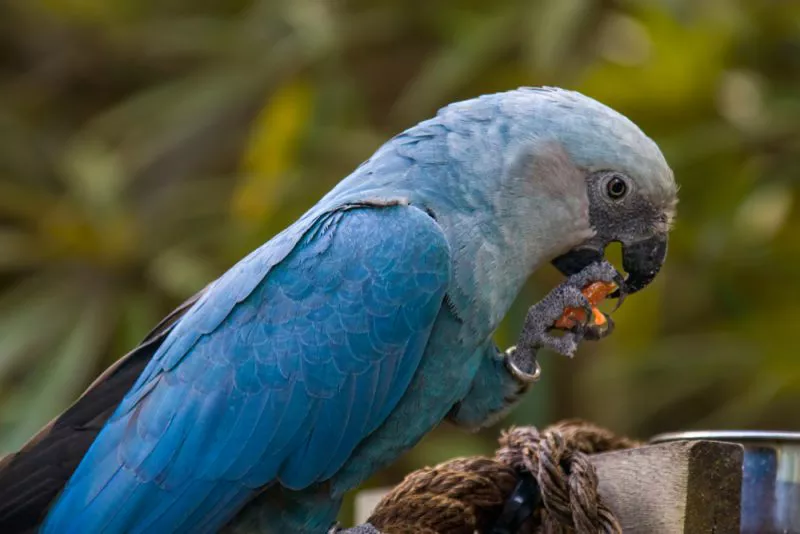Spix’s Macaw, also known as the Little Blue Macaw, is a rare, critically endangered species of bird that is native to Brazil. These stunning birds are best known for their vibrant blue feathers and playful personalities. Unfortunately, their population has declined significantly in recent years due to habitat loss and illegal pet trade.
One way to help conserve Spix’s Macaws is by understanding their dietary needs. In this article, we will explore what these birds eat in the wild and in captivity, as well as some important considerations for feeding them.
Natural Diet of Spix’s Macaws
In their natural habitat, Spix’s Macaws primarily feed on fruits, nuts, seeds, and flowers. They are opportunistic feeders and will consume whatever food sources are available to them in their environment. The macaws typically forage for food in the early morning or late afternoon when temperatures are cooler.
Some of the fruits that Spix’s Macaws eat include palm fruits like acuri, tucum, and bocaiuva, as well as other types of fruits such as guava, mango, and passion fruit. Nuts like cashews and almonds are also part of their diet, along with seeds from plants such as sunflowers and algarrobo trees.
Spix’s Macaws are also known to feed on flowers from various plant species. These flowers provide nectar, which is a source of carbohydrates and energy for the birds. Some of the flowers they consume include those from the mandacaru cactus and pau-brasil tree.
Feeding Spix’s Macaws in Captivity
As mentioned earlier, Spix’s Macaws are critically endangered, and there are only around 160 individuals remaining in the world. To help conserve the species, many of these birds are held in captivity in breeding programs, zoos, and other facilities. Feeding captive Spix’s Macaws can be a little more challenging than feeding their wild counterparts.
When feeding Spix’s Macaws in captivity, it is important to offer a varied diet that mimics their natural diet as closely as possible. This will help ensure they get all the nutrients they need to stay healthy and thrive. A balanced diet for captive Spix’s Macaws should consist of fruits, vegetables, nuts, seeds, and pellets.
Fruits: Offer a variety of fruits such as apples, bananas, grapes, kiwi, mango, papaya, and pomegranate. Avoid feeding citrus fruits as they can lead to calcium deficiencies.
Vegetables: Provide a mix of fresh vegetables like carrots, peas, sweet potato, green beans, and leafy greens such as kale and spinach. These will provide essential vitamins and minerals like Vitamin A.
Nuts and Seeds: Include nuts and seeds like almonds, cashews, sunflower seeds, and pumpkin seeds. These are an excellent source of protein and healthy fats.
Pellets: Pellets are specially formulated bird food that provides a balanced diet for macaws. Look for pellets that are specifically designed for large parrots like Spix’s Macaws, and avoid those with artificial colors or flavors.
It is also essential to avoid feeding Spix’s Macaws any toxic or dangerous foods like avocado, chocolate, caffeine, alcohol, and sugary or salty snacks. These can cause serious health problems and even death in some cases.
Feeding Considerations
When feeding Spix’s Macaws, there are some additional considerations to keep in mind to ensure they stay healthy and happy:
Water: Clean, fresh water should be available to Spix’s Macaws at all times. Change the water daily and make sure the container is large enough for them to bathe in if they wish.
Portion Control: It is important not to overfeed Spix’s Macaws as this can lead to obesity and other health problems. Offer small meals throughout the day and monitor their weight regularly.
Environmental Enrichment: In addition to a healthy diet, Spix’s Macaws also need mental stimulation and physical exercise. Provide toys, perches, and other forms of environmental enrichment to keep them active and engaged.
Consult with a Veterinarian: If you have any concerns about your Spix’s Macaw’s diet or health, consult with a veterinarian who specializes in avian medicine.
In conclusion, Spix’s Macaws are be autiful birds that require a balanced and varied diet to stay healthy and thrive. Whether in the wild or captivity, it is essential to provide them with plenty of fresh fruits, vegetables, nuts, seeds, and pellets while avoiding any toxic or dangerous foods. By understanding their dietary needs and taking proper care of these birds, we can help conserve this critically endangered species for generations to come.


 Facebook
Facebook  Instagram
Instagram  Youtube
Youtube 